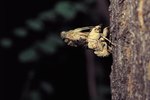
Wasps – a group of insects including yellow jackets, hornets, paper wasps and many others – are important components of Tennessee’s natural ecosystems. While any wasp may sting if provoked, some are more defensive than others. Of the species inhabiting Tennessee, yellowjackets, bald-faced hornets and “true” hornets are defensive and the most likely to sting, while paper wasps are relatively inoffensive. The numerous solitary wasps of Tennessee are capable of stinging, but rarely do so unless touched.
"True" Hornets
While people apply the term "hornet" to a variety of wasps, "true" hornets are members of the genus Vespa. The only hornets that inhabit Tennessee are the introduced European hornets (Vespa crabro). These large wasps often construct their nests inside tree hollows and other sheltered locations. European hornets are often quite defensive and warrant caution and respect. In some cases, these hornets girdle trees as they try to collect enough wood fibers to build their large nests.
Yellowjacket Wasps
Tennessee is home to seven different yellowjacket species (Vespula spp.). Often confused with bees, you can identify yellowjackets by their shiny bodies and reduced body hair. Yellowjackets are common picnic pests, and often scavenge bits of protein or drink droplets of sugary liquid. Most yellowjacket species nest in the ground, but German yellowjackets (Vespula germanica) nest almost exclusively between the walls of man-made structures. Yellowjackets are most likely to sting near their nests but they may sting if bothered while foraging as well. Despite the nuisance they represent, yellowjackets are beneficial predators of many insect pests, including caterpillars, grasshoppers and locusts.
Bald-Faced Hornets
Four species of bald-faced hornets are native to Tennessee. Also known as aerial yellow jackets, these large wasps are part of the same evolutionary clade as their ground-nesting kin, and are not “true” hornets. These tree-nesting wasps are usually less aggressive than their ground dwelling relatives are; however, one species, Dolichovespula arenaria, forms large, defensive colonies, containing as many as 700 workers. These large, aerial yellow jackets are capable of spraying adversaries with venom from their stingers.
Paper Wasps
Several paper wasp species inhabit Tennessee, but the most common are northern paper wasps (Polistes fuscatus). Paper wasps use their large mandibles to strip wood and bark from trees, chew the fibers and mix it with their saliva to make “paper.” They then use this paper to construct nests under roofs, awnings and tree branches. Near their nests, paper wasps may be very defensive; however, they rarely sting when foraging for food or wood. Adults primarily feed on nectar, but also capture caterpillars, which they feed to the developing larvae.
Solitary Wasps
While Tennessee's solitary wasps are capable of stinging, few ever do. (Reference 2 and Reference 6) Wasps of the Family Ichneumonidae are parasitic, and deposit eggs inside the bodies of other insects. When the eggs hatch, they begin consuming the host –often a caterpillar. Despite their incredibly long stingers used to inject eggs into the hosts, ichneumon wasps are generally shy. Though large and intimidating, cicada killers (Sphecius speciosus) typically reserve their venom for prey. These wasps, which often grow to more than 1 ½ inches in size, capture, kill and bury cicadas with a single egg – when the larva hatches, it consumes the prey. Mud daubers (Sceliphron caementarium), mud wasps (Chalybion californicum) and potter wasps (Eumeninae) are also solitary species that are unlikely to sting.
References
- The University of Tennessee Agricultural Extension Service: Yellow Jacket Wasps in Tennessee
- The University of Tennessee Agricultural Extension Service: Mud Daubers and Cicada Killers
- University of Idaho Extension: Homeowner Guide to Yellowjackets, Bald-Faced Hornets and Paper Wasps
- American Museum of Natural History: Vespinae
- Bug Guide: Polistes Fuscatus -- Northern Paper Was[
- Washington State University, Skagit County Extension: Ichneumon Wasps
Resources
Photo Credits
-
John Foxx/Stockbyte/Getty Images




